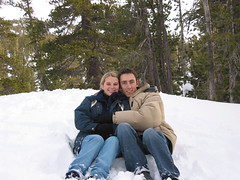The Temples of Angkor
3 days at the Temples of Angkor
February 9th-11th were 3 full days visiting the temples of Angkor (pronounced on-core)around Siem Reap. They were built between the 9th and 14th centuries by the Khmer civilization. This area was the centre of the Khmer empire and the temples are its remains. The stone structures were reserved for the Gods and places of worship; all other structures were made of wood and have since decayed.
On the first day (after changing hotels), we were picked up at 7:30 by our driver, Vannay and his tuk tuk (motorbike with carriage attached). We made a quick stop for a smoothie breakfast, and were on our way to the temples. Our first stop was the ticket centre, where we bought a 3-day pass, complete with photo. Unfortunately, most of our entrance fee (US$40 each) goes to Sokimex, a local petroleum company that 'owns' the Angkor temples, rather than to the upkeep and preservation of the temples. As tragic as this is, we either had to miss out on seeing the temples, or support the oil company. We're hopeful that the Cambodian government will wake up shortly and change this.
In general, the temples are made of sandstone and/or laterite. Most are designed where the temple in the centre represents a mountain (mostly Mt. Meru, a mythical Hindu mountain). The centre temple is usually a blunt-topped tower mounted on a tiered base. The sumit was the central sanctuary with an open door to the east and 3 false doors opening in the other directions (except Angkor Wat, which opens to the west. The west was the direction of death, leading experts to believe Angkor Wat was used as a tomb or mausoleum). Over time, this central tower was usually surrounded by more buildings, towers, sculptures and more elaborate works. Most of these places still have extremely elaborate and beautiful carvings in the sandstone. We learned a lot about Hinduism and mythological figures and stories, represented in these carvings and bas-reliefs. Most of these temples are still in various stages of repair, but some are still as the French found them in the 1860s, hidden in the jungle.
We won't bore you with the details of each temple we saw, as they really must be seen to be appreciated. We really enjoyed every one we saw, but our favourites were Banteay Srei, Ta Prohm and the East Gate. Of course Angkor Wat, the most famous and the largest temple (depicted on the Cambodian flag), was stunning as well. It was particularly beautiful at sunrise.
Our 3 days at the temples were long and full, and we could have stayed a bit longer. We had a few meals in the evenings with some people we met way back in Battambang in the back of the truck and on the boat: Jarrod (Melbourne via Hong Kong), Tim & Barry (Ireland) and June (China). We very much enjoyed their company and hope to meet up with Jarrod in Hong Kong and Tim and Barry in South America. Of course we also treated ourselves to a massage on two of the nights. We ate really well in Siem Reap, although it's expensive. When we can find a place to upload photos, we'll be sure to put a few from Angkor, but they will not even be close to actually being there and seeing them, despite our stellar photography skills.


0 Comments:
Post a Comment
<< Home